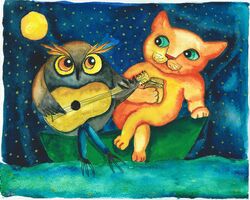
Recent illustration for "The Owl and the Pussycat" by artist Julia Hartling.
"The Owl and the Pussycat" is a nonsense poem by the British artist and writer Edward Lear. The poem was written in December 1867 for Janet Symonds, the three-year-old daughter of Lear's friend the writer John Addington Symonds It was first published in 1871 as part of Lear's anthology Nonsense Songs, Stories, Botany and Alphabets.
The poem concerns an owl and a cat[1] who, while traveling at sea, get engaged and then search for a wedding ring.
"The Owl and the Pussycat" has frequently been referenced in popular culture. It has been set to music and recorded as a song numerous times. One of the most popular musical versions of "The Owl and the Pussycat" was recorded in 1955 by the British actor and guitarist Elton Heyes, using a tune to which the poem was set in 1927 by the South African-born composer Victor Hely-Hutchinson.
The poem has been translated into more than a hundred different languages, including Cornish, Scottish Gaelic, Welsh, Greenlandic, Hawaiian, Quechua, Maori, Zulu, Latin, Ancient Egyptian hieroglyphs, Esperanto and Klingon.
Beatrix Potter's 1930 children's novel The Tale of Little Pig Robinson is a prequel to "The Owl and the Pussycat".
Summary[]

Illustration for "The Owl and the Pussycat" by Lucille Enders from the 1922 book Journeys through Bookland - A New and Original Plan for Reading Applied to the World's Best Literature for Children.
The Owl and the Pussycat are traveling by sea in a "beautiful pea green boat". Their provisions consist of some honey and a five-pound note which has a lot more money wrapped up inside it. At night, the Owl plays the guitar and serenades the Pussycat with a love song. Very moved by the song, the Pussycat proposes marriage to the Owl. Unfortunately, they do not have a wedding ring.
After traveling in their boat for a year and a day, the Owl and the Pussycat reach the land where the Bong-tree[2] grows. In a wood, they find a pig with a ring in the end of his nose. The Owl and the Pussycat buy the ring from the pig for one shilling.
The following day, the Owl and the Pussycat are married. The ceremony is performed by a turkey. At their wedding feast, the Owl and the Pussycat eat minced meat and slices of quince with a runcible spoon.[3] Afterwards, they dance on the beach by moonlight.
See also[]
- Audio file of a reading of "The Owl and the Pussycat" (British male reader)
Footnotes[]
- ↑ The Owl is usually imagined as being male and the Pussycat as being female although this is not explicitly stated in the poem. Some support for the idea of the cat being female can be found in the fact that the Owl calls the Pussycat "beautiful', rather than "handsome".
- ↑ In the context of this poem, "Bong" is simply a nonsense word which has no meaning.
- ↑ The word "runcible" was invented by Lear as a nonsense word without any meaning. In other poems, Lear refers to a "runcible hat" a "runcible cat' and a "runcible goose". Since the 1920s, however, several dictionaries have provided definitions for "runcible spoon". Most dictionaries define "runcible spoon" as either a synonym for grapefruit spoon or spork. According to Brewer's Dictionary of Phrase and Fable, a "runcible spoon" is a spoon which has a bowl at each end, one large and one small. None of those definitions, however, match the image of a runcible spoon which Lear drew. A poem in Lear's book Twenty-Six Nonsense Rhymes and Pictures describes a duck that uses a runcible spoon to catch frogs which it eats. The accompanying illustration shows a duck holding a long spoon with a large bowl in its beak.
